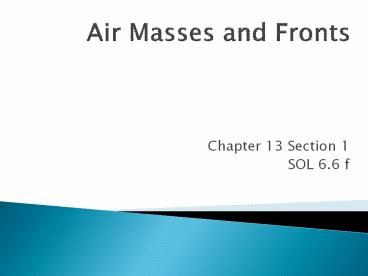Air Masses and Fronts PowerPoint PPT Presentation
1 / 24
Title: Air Masses and Fronts
1
Air Masses and Fronts
- Chapter 13 Section 1
- SOL 6.6 f
2
- Air mass a huge body of air that has similar
temperature, humidity and air pressure
throughout. - Air masses are classified according to 2
characteristics temperature and humidity. - CFU How are air masses classified?
3
- According to temperature
- Tropical or warm air masses form in the tropics
and have low air pressure. - Polar or cold air masses form in the north and
have high air pressure. - CFU Compare and contrast tropical and polar air
masses.
4
(No Transcript)
5
- According to humidity
- Maritime air masses form over water and have a
high humidity. - Continental air masses form over land and have a
low humidity. - CFU Compare and contrast Maritime and
Continental air masses.
6
(No Transcript)
7
- Maritime Tropical
- Warm, humid air mass that forms over oceans near
the tropics (Gulf of Mexico, Atlantic/Pacific
Ocean). - In summer, they bring hot, humid weather and form
most showers and thunderstorms. - In the winter, they bring heavy rain or snow.
- CFU Describe a MaritimeTropical Air Mass.
8
- Maritime Polar
- Cool, humid air mass that forms over the icy cold
North Pacific or North Atlantic oceans. - Affect the west coast more than the east coast.
- Often bring fog, rain, and cool temperatures even
in the summer months to the west coast. - CFU Describe a Maritime Polar Air Mass.
9
- Continental Tropical
- Hot, dry air masses that form only in summer over
dry areas of Southwest and northern Mexico. - Cover a smaller area than other air masses.
- Bring hot, dry weather to southern Great Plains
when they move their usual Northeast. - CFU Describe a Continental Tropical Air Mass.
10
- Continental Polar
- Large air masses that form over central and
northern Canada and Alaska. - Bring cool or cold air.
- In winter, they bring clear, cold, dry air to
much of North America-- can bring bitterly cold
temperatures with very low humidity. - In summer, storms may occur when the polar air
masses meet the tropical air masses. - CFU Describe a ContinentalPolar Air Mass.
11
(No Transcript)
12
- Air masses tend to move from West to East.
- As huge masses of air move across the land and
the oceans, they bump into each other. But they
do NOT easily mix (think oil and vinegar).
13
- The area where the two air masses meet and do not
mix becomes a front. There are four different
types - Cold front cold air overcoming warm air. Warm
air is pushed upward and as it rises and cools,
clouds are formed. If there is a lot of water
vapor in the warm air, heavy rain or snow may
fall. They move quickly and can cause abrupt
weather such as thunderstorms. - CFU What do you call the area where two air
masses meet but dont mix?
14
(No Transcript)
15
- Warm front warm air overcoming cold air. Can
bring clouds, storms and rain. These fronts move
slower and can cause rainy weather and fog for
several days. Usually leaves behind warm, humid
weather. In winter, warm fronts bring snow. - CFU What kind of weather is usually associated
with a warm front?
16
(No Transcript)
17
- Stationary frontcold and warm battling it out in
a standoff. Where the two air masses meet,
water vapor in the air condenses into rain, snow,
fog or clouds. Can bring many days of clouds and
precipitation. - CFU Describe a stationary front.
18
(No Transcript)
19
- Symbols
- Cold Front
- Warm Front
- Stationary Front
Icicles (triangles) Suns (half
circles) Both on opposite sides
20
- Occluded frontmost complex. Warm air mass
sandwiched in between 2 cold air masses which
pushes the warm air upward. The 2 cooler air
masses meet and warm air is cut off. The weather
may turn cloudy, rainy or snowy.
21
(No Transcript)
22
- Low pressure areas (also known as a cyclones)
bring bad weather such as storms and
precipitation and are represented by L on a
map. - High pressure areas (also known as anti-cyclones)
bring good weather and are represented by H on
a map. - CFU What kind of weather do you expect with Low
Pressure? High Pressure?
23
(No Transcript)
24
- Low Pressure Bad Weather L
- High Pressure Good Weather H

